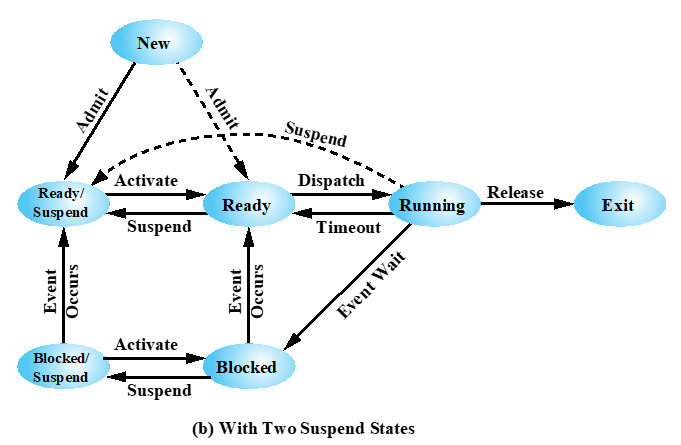OS Review 1
1/30
There's no tags or description
Looks like no tags are added yet.
Name | Mastery | Learn | Test | Matching | Spaced |
|---|
No study sessions yet.
31 Terms
What are three objectives of an OS design?
Convenience
Efficiency
Ability to Evolve
What is the kernel of an OS?
The part of the OS that has direct access to the hardware.
What is multiprogramming?
When the processor switches between different programs mid-run.
What is a process?
A program to be executed by the processor.
How is the execution context of a process used by the OS?
It is used to determine a program’s priority and how much time and memory it is allocated.
List and briefly explain five storage management responsibilities of a typical OS.
Process Isolation
Memory Management
Modular Programming Support
Access Control
Long-term Storage
Explain the distinction between a real address and a virtual address.
A real address is an actual location in memory.
A virtual address is a symbol that points towards a real address in memory.
Describe the round-robin scheduling technique.
Round-Robin is when the processor will rotate between active programs in queue.
Explain the difference between a monolithic kernel and a microkernel.
A monolithic kernel will handle every system on the computer, exposing everything to memory.
A microkernel will only control a few essential functions, such as scheduling and addressing. Everything else is assigned to its own system.
What is multithreading?
Using multiple processors to work multiple tasks at once.
List the key design issues for an SMP operating system.
Multiprogramming Support
Scheduling
Synchronization
Memory Management
Reliability
Contrast the scheduling policies you might use when trying to optimize a time-sharing system with those you would use to optimize a multiprogrammed batch system.
A time-sharing system would prioritize I/O over speed, while a multiprogrammed system would prioritize speed over I/O.
What is the purpose of system calls, and how do system calls relate to the OS and to the concept of dual-mode (kernel-mode and user-mode) operation?
A system call is used when a user-mode program wants to perform a kernel-mode action and must ask the processor to do it.
What is an instruction trace?
A list of program instructions that either have been or are going to be executed.
What common events lead to the creation of a process?
New Batch Job
User Login
OS Service
Child of Parent Service
For the processing model of Figure 3.6, briefly define each state.
New – Process is set to be admitted.
Ready – Process is ready to be executed.
Running – Process is being executed.
Blocked – Process has been interrupted.
Exit – Process has finished.
What is swapping and what is its purpose?
Swapping moves parts of a process from main memory to disk. This is usually done if a program requires I/O, since disk I/O is faster than system I/O.
Why does Figure 3.9b have two blocked states?
So processes can be considered “ready” or “blocked” while being suspended.
List four characteristics of a suspended process.
Not immediately available.
May be waiting on an event.
Placed in suspension via itself, parent, or OS.
May not be activated unless the suspender says so.
List three general categories of information in a process control block.
IDs
Control & Status Registers
Control Information
Why are two modes (user and kernel) needed?
So the OS can distinguish between programs that need direct access to memory and programs that don’t need/shouldn’t have direct access to memory.
What are the steps performed by an OS to create a new process?
Assign ID.
Allocate memory.
Init control block.
Set needed links.
Create/expand other structs.
What is the difference between an interrupt and a trap?
An interrupt is a request from the program, parent, or OS for purpose of waiting on an event.
A trap is a demand from the OS to handle an error or exception.
Give three examples of an interrupt.
Clock Interrupt
I/O Interrupt
Memory Fault
Turnaround Time =
\text{I/O Time}+\text{Process Time}
Throughput given n jobs =
avg(\text{Turnaround Time})
Processor Utilization =
\frac{\text{Process Time}}{\text{Turnaround Time}}

This is a…
5-State Queueing Model

This is a…
7-State Process Model
Residency
Whether or not something is a part of main memory.
Suspension
Swaps a program to disk.